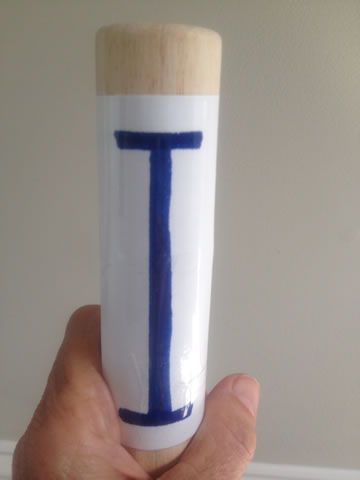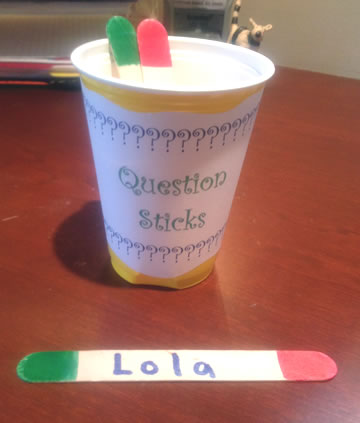October 2015
ALL DAY LONG
Here are some activities that will encourage children to talk, listen, and learn throughout the day.
Complete Sentences – Encourage children to answer questions in complete sentences. Repeat the sentence correctly and expect them to echo it back.
Routines - Take advantage of “teachable moments” in the day.
Greet children by shaking their right hand and saying, “Good morning, child’s name.” The child responds, “Good morning, teacher’s name.”
Compliment Circle - Use a “compliment circle” where children go around the group and make positive comments about friends.
Tell Me Something Good – Go around the classroom each morning and ask children to state something “good” about the day.
iPhone – Make an iPhone by writing a capital “I” on an index card and taping it to a cylinder block. Have children pass the microphone around as they take turns talking. Only the person holding the iPhone is allowed to talk.
•Put a sticker (volume control) on the cylinder block and if they talk too softly ask them to “turn up the volume.” Likewise, if they are too loud ask them to “turn it down.”
•Pass around a beanbag, sponge ball, or other small toy to designate who the speaker is.
Partner Share – Let children get a buddy and talk about their day, their
favorite part of a story, their family, and other topics.
Show, Share, and Then Some - Ask children to bring an object to share that relates to a theme or concept. For example, they could bring in something red, a sign of fall, or something that starts with H. After sharing time encourage each child to remember something about what a friend brought.
•Create a special child size podium (box or music stand) for sharing time.
•Ask the “audience” to close their eyes so they can concentrate on what the speaker is saying. Have the children open their eyes and recall information.
Happy Bag – Get a cloth bag and decorate it with “Happy Bag.” One child gets to take the bag home each night and put a special object in it. Ask parents to help their child write 3 clues about what is in the bag or use this rhyme:
I don’t mean to brag,
But I have something in my bag.
If you listen to my clue,
I bet you can guess it, too.
It rhymes with___________.
Classmates get to practice asking questions to determine what could be in the bag. Encourage children to use complete sentences when asking questions.
Photos – A picture is worth a thousand words, and children will be eager to discuss photos you take of them at school.
•They will also enjoy bringing pictures from home and talking about their families and experiences.
Echo Game – The teacher begins the game by cupping hands around
her mouth and saying, “Yoo hoo.” Children repeat, “Yoo hoo.” The
teacher then makes another statement. Children have to listen and echo
back what the teacher says.
•Let children take turns being the leader in this game as their friends echo back.
•Stretch out sounds in words and have children blend them.
Act Out Stories – Invite children to act out stories you have read. “Caps for Sale,” “The Gingerbread Boy,” and many other traditional tales can come to life!
Role-Play – Role-play answering the phone, what to do when a stranger comes up to you, what to do if someone bullies you, and other life experiences.
Puppets, Puppets, Puppets – Stick puppets, sock puppets, sack puppets, handmade or expensive puppets all have a magic quality on the hand of a child. Puppets can be used for rhymes, songs, poems, stories, or to act out feelings.
Jump Rope Rhymes – You don’t need ropes, just stand up and start saying the rhymes you learned as a child as you jump up and down.
Patty Cake – Oral language, spatial awareness, eye hand coordination, and social skills are all enhanced when children say patty cake chants.
Big Books and Charts – Through choral reading of big books and language experience charts, children develop important concepts about print as well as left to right orientation.
Chime In – Encourage children to chime in on repetitive lines when you read.
•Begin reading and then stop and let them supply a missing word.
Say What? Say rhymes or read familiar stories incorrectly. When children catch you making a mistake they chant, “Say what?” The teacher then asks them to repeat it correctly.
American Idol – If you have a few extra minutes during the day, choose
a child to play “American Idol” and lead classmates in a favorite song.
Dictation - Encourage children to dictate sentences about paintings, drawings, and other artwork. Sweep your finger under the words and then ask the child to read along with you.
Complete Sentences – Make predictable books or class experience charts where children complete simple sentences such as: I wish…Love is…If I had wings…I see…I am afraid of…When I grow up…
Mirrors – Children love to look at themselves in the mirror and talk. Pass a hand mirror around morning meeting and let children describe how they feel.
•Put a large mirror in your classroom library so children can read to themselves in the mirror.
Learning Centers – Dramatic play, blocks, manipulatives, science, art, games, and other small group experiences provide children with the opportunity to talk and learn.
Partner Projects – Allowing children read, draw, play games, build, retell stories, or do other activities with another child will open up conversation.
THAT'S A GOOD QUESTION
Asking questions and giving children time to respond orally will develop thinking and speaking skills across the curriculum. Here are some powerful strategies to help kids “think outside the box.”
Open-ended – Ask open-ended questions, rather than “yes” or “no.”
Convergent questions have one answer, but divergent questions encourage students to make new connections and think outside the box.
Acknowledge Responses – Avoid judging answers by repeating their response. “Good thinking!” “That’s close.” “I never thought about that before.” “Kiss your brain!”
How did you know that? Encourage children to “think out loud.” This will help peers develop higher thinking skills.
Give Time (Smile! J) – Help children think about what they want to say and by asking children to smile if they know the answer.
Pop Up Q & A – Divide students into pairs. Ask a question. Partners discuss the answer and stoop down when they have agreed. When all pairs are down the teacher says, “1, 2, 3, tell.” The children pop up and say the answer out loud.
Thumbs Up Thinking – Tell children to stick up their thumb next to their chest if they have learned something. Stick up fingers for each additional thing you’ve learned.
Whisper & Release – Children whisper the answer in their fists. When the teacher says, “Release,” the students open their fists.
Pick Sticks – Ask each child to write his/her name on a jumbo craft stick. Color one end green and one end red. Place the sticks in a cup so the green end is up. Ask a question, and then choose a stick. That child gets to answer the question. Return their stick to the can with the red end up. When all the sticks are red, turn them over and begin again.

